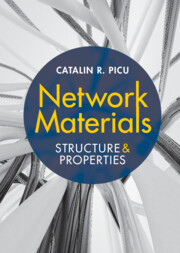Book contents
- Network Materials
- Network Materials
- Copyright page
- Contents
- Preface
- 1 Introduction
- 2 Fibers and Fiber Bundles
- 3 Fiber Interactions
- 4 Network Structure and Geometric Parameters
- 5 Affine Deformation
- 6 Mechanical Behavior and Relation to Structural Parameters
- 7 Constitutive Formulations for Network Materials
- 8 Strength and Toughness of Network Materials
- 9 Time Dependent Behavior
- 10 Networks with Fiber Surface Interactions
- 11 Composite Networks
- Index
- References
1 - Introduction
Definitions and Classification
Published online by Cambridge University Press: 15 September 2022
- Network Materials
- Network Materials
- Copyright page
- Contents
- Preface
- 1 Introduction
- 2 Fibers and Fiber Bundles
- 3 Fiber Interactions
- 4 Network Structure and Geometric Parameters
- 5 Affine Deformation
- 6 Mechanical Behavior and Relation to Structural Parameters
- 7 Constitutive Formulations for Network Materials
- 8 Strength and Toughness of Network Materials
- 9 Time Dependent Behavior
- 10 Networks with Fiber Surface Interactions
- 11 Composite Networks
- Index
- References
Summary
This introductory chapter defines the class of Network materials and provides numerous examples. Network materials are classified based on several criteria. They are divided into thermal and athermal, as a function of the dependence of the fiber behavior on temperature, in dry, embedded or embedding, as a function of the presence of embedded entities (nanoparticles, macromolecular entities) or of an embedding matrix, in crosslinked and non-crosslinked function of the nature of fiber interactions. This classification is used in the book to define categories of mechanical behavior. The chapter closes with an outline of the book.
- Type
- Chapter
- Information
- Network MaterialsStructure and Properties, pp. 1 - 12Publisher: Cambridge University PressPrint publication year: 2022

